Domino's Family History
Domino's Family History
BLOODLINE HISTORY
Double Six Domino began his life in 1943 on Jack Mansfield's vast Alamosa Ranch in Texas. The colt, born black with a large white blanket and peacock spots, was sired by Mansfield's Comanche, and out of an unregistered Appaloosa mare by the name of Susan. Jack Mansfield's horse breeding program relied heavily on line breeding, so it is certainly possible that Susan was a Mansfield's Comanche daughter bred back to her sire. "Domino" had coloring very similar to his sire, and his long-bodied conformation was reminiscent of Juanita, the dam of Mansfield's Comanche.
In 1955, the horse then called Domino had already changed hands several times. He had matured to over 14 hands and had become an attractive blue roan. His owner at the time was Elvin Blevins, who also owned a Buttons B., a Domino son. When Harmon Scales of Lubbock, Texas, heard of the high quality horses Blevins was breeding, he immediately drove to Blevins' Oklahoma ranch to take a look at some stud prospects. Even though Domino was in poor shape (after a violent clash with Buttons B.) his reputation preceded him; Scales soon purchased Domino and took him back to Texas. It was Scales who registered the stallion as Double Six Domino F-2646.
Although Double Six Domino's battle with Buttons B. had caused the stallion some fertility problems, Scales believed the foals Double Six Domino did produce, although small in number, were worth the trouble (Domino's fertility problems lessened with time). The stallion was used by Scales exclusively as a sire, a trend that began with Jack Mansfield and would continue with every owner Double Six Domino would have. But even without the benefit of a show record, Double Six Domino won awards and gained titles. His ability to sire horses better than himself allowed him to place in the top five in get of sire classes at the Appaloosa National Shows in 1960, 1962, and 1964, and take top honors in the class in 1959 and 1970. In 1971, a year after his get of sire triumph at the National Show, Double Six Domino died quietly at a ranch in Florida at the age of 28.
Double Six Domino sired nearly 250 registered Appaloosa foals; they were successful racehorses, halter champions, and performance horses alike. One of his best known sons, Whistle Britches, was at one time owned and promoted by Carl Miles, who would later own and promote Joker B. and Prince Plaudit. Whistle Britches was the sire of Natio
nal Show halter winners Little Britches, Navajo Britches and Yellow Jacket. Navajo Britches became one of the top four leading race sires from 1963-1968 with the help of his get Boogie Britches and Nava Star, as well as a sire of halter champions Arapaho Britches, Bridgette Britches, and Boomer Britches. Buttons B. acquired his Appaloosa National Show get of sire championship with the help of his get Comanche Ki, Quavo B. and Poteet B, who later became champion sires as well. Other notable Double Six Domino get include Double Five Domino, Dominette, Tick Tock, and Copper Domino.
As a race sire, Double Six Domino produced starters such as Domleo Bar, Charlo, and Sue Domino. Thanks to the success of his racing get, Double Six Domino earned a place in the top 50 Appaloosa race sires. His get earned over $20,000 at the track.
Double Six Domino was never ridden or shown by any of his numerous owners, but that didn't stop the stallion from becoming one of the most popular sires of his time. Even today top Appaloosa stallions such as Wap Spotted sport his name on their pedigree. Double Six Domino was inducted into the Appaloosa Horse Club Hall of Fame in 1988
|
In the early 1900’s, rancher Jack Mansfield bought a large Texas ranch bordering the Rio Grande. Wild horses roamed much of the land, and many of the horses that ran wild on his ranch, Mansfield noted, were Appaloosas. To make room for cattle to graze, Mansfield rounded up and sold much of the wild horse stock on his ranch; however, he kept several of the better mares to begin his own breeding program to produce his own ranch horses.
To begin his breeding program, Mansfield first acquired several Quarter Horse stallions, then, when they became more readily available, he added Thoroughbred remount stallions to refine his stock. One such Thoroughbred stallion, Dr. Howard (a grandson of Kentucky Derby winner Ben Brush), became Mansfield’s Comanche’s sire. Comanche’s dam, Juanita, was a roan Appaloosa with large spots on her hips. She was bred to Dr. Howard, and in 1933 she gave birth to the colorful Mansfield’s Comanche. Jack Mansfield saw promise in Comanche and, unlike most of the colts born on the ranch, Comanche was never gelded.
When Mansfield moved his Alamosa Ranch facilities to Vega, Texas, he also moved Juanita, Comanche, and a few other select horses to continue his breeding program. At the new facilities, Comanche began his training as a ranch horse, which he took to quickly thanks to his even temperament, smooth gaits, and intelligence. Finally, it was agreed that Comanche should be used as a herd sire. The next breeding season, Comanche was turned out onto Mansfield’s Texas ranch with a band of mares. The resulting foals had the color and excellence possessed by their sire, and many were sold to ranchers throughout the region. When Jack Mansfield saw the quality of his Comanche foals, he began an intensive line breeding program, breeding Comanche daughters back to Comanche several times to produce his desired result.
Throughout his life, Mansfield’s Comanche was never shown and never promoted as a sire, instead gathering most of his renown through word of mouth. Jack Mansfield didn’t register any of his Appaloosas in the Appaloosa Horse Club until shortly before Comanche’s death, and less than 40 of Comanche’s get were ever registered. But despite his small number of registered get, Mansfield’s Comanche managed to sire several outstanding ApHC horses. Some of his best known get include Double Six Domino, who was a leading halter and race sire during the mid-sixties and won first place Get of Sire honors at the National Show in 1970. Other great Comanche get include Caliente, Comanche’s Equal, Oklahoma, Speckle Butt, Comanche Rondo, and Cherokee A. Comanche is also the grandsire of several champions, including Ghost of Comanche, the 1965 champion money-earning three year old racehorse; Whistle Britches, a leading sire and sire of champion Navajo Britches; Silver Strikes Equal, winning racehorse and National grand champion stallion in 1968 and 1971; race winner Gold Strikes Equal; and High Spot.
Jack Mansfield never sold his famed stallion. Mansfield's Comanche died in 1959 at the age of 26 on the Alamosa Ranch after being struck by lightning. He was inducted into the Appaloosa Horse Club Hall of Fame in 1988.
|
Patchy F-416 was born in 1939 on a ranch in Ewan, Washington, and would become well-known for his incredible stamina, correct conformation, loud color, and his ability to sire horses with the same traits. Patchy was sired by Patches (later registered as General Blucher F-77), and was a grandson of the stallion Baby Patches. Patchy's dam, Miss Rosalia, was a unraced but registered Thoroughbred mare by Ponce de Leon and out of Miss Tempo.
Originally owned and bred by Guy Lamb of Lewiston, Idaho, Patchy changed hands in 1942, when he was sold to Herb Camp, who used him as a ranch horse and herdsire. After visiting Camp’s ranch, then-ApHC Executive Secretary George Hatley encouraged Camp to enter Patchy in the Appaloosa Horse Club’s First National Show. Hatley’s encouragement paid off when Patchy walked away with the award for National Grand Champion Stallion of 1948.
In 1950 Patchy again changed hands, this time to Ben Johnson of Colorado. He was used as a ranch horse, was packed into the Colorado Rockies, and was again used as a herdsire. In 1952 Patchy - now in his mid-teens - was entered again in the National Appaloosa Show. Patchy competed in eleven of the thirteen offered classes at a time when all of the Performance classes were held in one night, and walked away with the National Champion Performance Horse title for 1952.
As with many foundation Appaloosa stallions, Patchy was never widely advertised as a sire. He still, however, was able to make his mark in Appalossa breeding with his 84 registered foals. Patchy placed high in National get of sire classes in 1953, 1955, and 1959, and in 1960 was named premier sire of performance horses. He sired three national champions – Gypsy, Blitz, and Patchy Jr. – as well as the horses Patchy Pete, Lolo, and Keeko. His grand-get include Shavano, Double Patch, Patchy III, and Toby II’s Patchy.
In 1961, half interest in Patchy was sold to Don and Jimmie Imboden, and it was at their ranch in Sioux City, Iowa that the stallion died in 1963. Patchy F-416 was inducted into the Appaloosa Horse Club Hall of Fame in 1986.
|
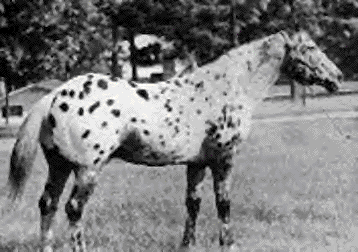 |
Double 6 Domino
 |
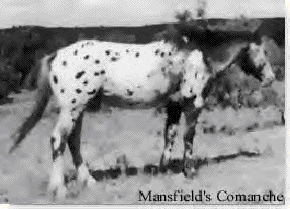 |
Mansfield Commanche
|
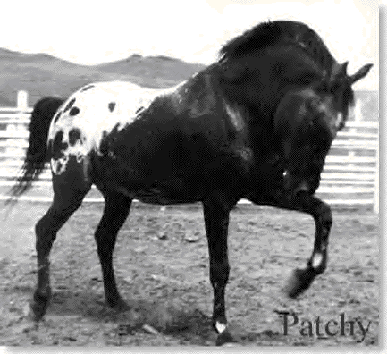 |
Patchy
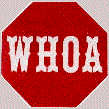 |
Foaled on the Maddon Ranch in New Mexico in 1950, Bright Eyes Brother’s was indisputably an Appaloosa. The colt’s sire was the AQHA registered Billy Maddon, so it was deduced that the colt’s color had come from none other than his dam, the unregistered Plaudette. Plaudette was by the Thoroughbred stallion King Plaudit, and was a sprint and match race mare. As a broodmare, it was clear that she passed on her running abilities to her offspring when she produced the three time AQHA champion running mare Maddon’s Bright Eyes. But despite having foaled AQHA registered horses in the past, Plaudette obviously carried some Appaloosa in her blood, and this was evidenced when foaled the attractive buckskin blanketed colt that would come to be known as Bright Eyes Brother.
As a two year old, Bright Eyes Brother – then called Frosty – was sold to Wiley Donaldson, who used the colt as a rodeo horse; he found that Frosty was very adept around cattle, especially in roping events. Because Donaldson and his family treated the horse more as a pet than anything else, during Frosty’s five years with Donaldson he was rarely used as a sire – and while he did sire five foals during that time, three were from stock mares he covered when he got loose at a rodeo.
While the buckskin stallion was busied with rodeos, a Colorado-based auctioneer had been listening to stories about the horse for years. That auctioneer, whose name would become forever intertwined with that of Bright Eyes Brother, was Cecil Dobbin. Dobbin had seen prices for Appaloosas in auctions soar, and decided that the well-bred stallion would make a good herd sire to begin his own breeding program. Dobbin kept his ear to the ground for two years before he finally found Frosty on Wiley Donaldson’s ranch. Dobbin first offered Donaldson any rodeo horse on the circuit that was for sale in exchange for Frosty, but Donaldson refused. Not to be discouraged, Dobbin returned to Donaldson's ranch with $10,000 from his savings account, as well another $10,000 loaned from a friend, and eventually enticed Donaldson to sell the stallion without having to dip into the second $10,000. A wave of guilt swept Dobbin as he watched Donaldson's young daughter say a teary goodbye to Frosty as she fed him gumdrops out of her hand; but the deal had been made, and Dobbin left with the stallion.
Returning to Colorado with Frosty, Dobbin made a stop at a phone to call his friend Dick Spencer and boast about his newest acquisition. When Spencer found out that the horse was a half brother to the famous Maddon’s Bright Eyes, he jokingly told Dobbin to call the horse Bright Eye’s Brother, since “that’s what you're going to be telling everyone” – and the name stuck.
In Colorado, Dobbin registered the horse with the Appaloosa Horse Club and promptly began Bright Eyes Brothers’ show career. Most notably, the stallion competed regularly at the Denver National Western Stock Show. After winning grand champion Appaloosa stallion at the show, he was invited to show at the San Antonio Livestock Show in 1958. After his arrival, Dobbin put Bright Eyes Brothers’ pedigree on the horses’ stall for everyone to see, creating a stir among AQHA breeders, some who were amazed – others angry – that an Appaloosa could be related to their illustrious mare Maddon’s Bright Eyes. Despite the controversy, Bright Eyes Brother easily took home the 1958 grand champion Appaloosa stallion title, only to create another stir when he and Dobbin walked in the Parade of Champions - an honor usually reserved for the Quarter Horses.
Throughout Bright Eyes Brother's career as a stud, Dobbin continually received offers to buy the stallion - Dobbin even received a $50,000 offer for half interest in the stallion before any of his foals had been born - but Dobbin always refused, even turning down an offer from legendary breeder Hank Weiscamp. Dobbin also rarely sold the foals Bright Eyes Brother sired until they were yearlings, giving him a chance to appraise the product of his breeding program.
As a sire, Bright Eyes Brother produced 138 registered offspring. Cecil Dobbin was a believer in quality not quantity, and bred the horse to what were usually fewer than 20 mares each breeding season. Dobbin handpicked the mares that he bred Bright Eyes Brother to, usually choosing mares who were from Coke Roberds and Mavis Peavy bloodlines. Dobbin rarely bred the stallion to outside mares, preferring to instead to sell the Bright Eyes Brother offspring his ranch produced. One notable exception to this rule was Bright Eyes Brother's breedings to Lane Hudson's mare Peggy's Delight, producing the famed Mighty Bright and his subsequent full siblings Bright Delight, Bright Cecil, Gypsy Delight, and Barely Bright.
Bright Eyes Brother sired several well known Appaloosas, including Hall of Fame stallions Mighty Bright and Bright Chip, Hall of Fame mare Bright Starlette, 1963 Appaloosa National Show grand champion mare Bright Delight, National and World champion Bright Reflection, and two time National champion Bright Tribute. Bright Eyes Brother is in turn the grandsire of the stallions Mighty Marshall, Mighty Paul, and Mighty Peavy. Bright Eyes Brother also has the distinction of being the sire with the most offspring in the Appaloosa Horse Club Hall of Fame.
Bright Eyes Brother died in 1979 at the age of 29. He was inducted into the Appaloosa Horse Club Hall of Fame in 1988.
|
The foaling of Appaloosa stallion Mighty Bright had been a long time in coming. His breeder, Lane Hudson, had spotted Cecil Dobbin’s famed stallion Bright Eyes Brother at the 1958 Colorado State Fair, and immediately began a meticulous search for the right mare to breed to him. After over a year of searching, Hudson received a tip on a mare – AQHA registered Peggy’s Delight. Peggy’s Delight was by Red Dog P-55 (AQHA), making her a half sister to Joker B. Hudson theorized that Peggy’s Delight’s bloodlines would mix well with those of Bright Eyes Brother, whose pedigree traced back to foundation sires Peter McCue and Old Fred. After locating Fred Field, the owner of Peggy’s Delight, Hudson began negotiating for her purchase. Hudson’s first trip to the Field ranch was unfruitful, and he returned home with an empty horse trailer. But four months after his initial attempt, Hudson received a call from Field, and arrangements were made to sell Peggy's Delight at Hudson’s final price.
Hudson took her to be bred to Bright Eyes Brother immediately, and eleven months later, on April 15, 1960, Mighty Bright was foaled on Lane Hudson’s ranch. Hudson hadn’t been present at the foaling, and was taken aback after spotting the foal while doing chores. The new colt stood facing Hudson, his gangly legs each marked with a white stocking, and he stared at his breeder from a flashy bald face. At first, Hudson detected no Appaloosa markings on the red dun foal, and worried he may be “in the middle of a helluva wreck”, but further inspection proved Mighty Bright wore a frosty white blanket on his hind end.
Pleased with the end result of his shrewd breeding, Hudson soon began preparing Mighty Bright for shows.
Mighty Bright was shown in halter three times as a weanling, winning at all three events. At the end of the show season that year, he received the Mountain and Plains Appaloosa Association High Point Weanling award. At one point during the 1960 show season, the ever-prominent Hank Weiscamp offered Lane Hudson $10,000 for the colt, but Hudson refused - he knew such an offer from Weiscamp meant the colt was well worth holding on to. The beginning of Mighty Bright’s 1961 show season proved disastrous when the yearling was involved in an accident prior the Denver National Western Stock Show. Mighty Bright sustained a broken leg, and while the leg eventually mended fully, it ended the up and coming colt’s show career for good.
Luckily for Might Bright, Lane Hudson knew the colt had more to offer than a show record, and in 1963 Mighty Bright’s first foal crop hit the ground. One of the foals from his first crop was Mighty Peavy, who won National Champion Get of Sire honors in 1970 and 1978. In 1964 Mighty Bright found himself the sire of another outstanding foal crop which included Mighty Paul, Mighty Marshall, and Mighty Sheik. Mighty Sheik, a full brother to Mighty Peavy, won National Champion Get of Sire honors in 1974. Mighty Peavy and Mighty Sheik are the only two full brothers to ever both win National Championships in Get of Sire.
By 1970, Mighty Bright had acquired a top quality broodmare band and was one of the top sires in the country. Lane Hudson began turning his attention to his up and coming junior stallion, and in 1971 he leased Mighty Bright to Jack Ryan. Ryan moved the stallion to his Corpus Christi, Texas ranch, where Mighty Bright sired 19 more foals. Later that year, Mighty Bright was sold for the very first time to Dr. George Gayle of Houston, Texas. Dr. Gayle was the president of the Texas Appaloosa Horse Club and an Appaloosa Horse Club director. One of Gayle’s first foals sired by Mighty Bright was Mighty Gayle, who became a National and World champion.
Mighty Bright’s siring abilities eventually earned him the first Greater Eastern Appaloosa Regional (GEAR) Supreme Champion Sire of Performance Horses award. He was known throughout the Appaloosa world as being able to sire horses with outstanding producing abilities. Mighty Bright sired a total of 189 registered foals. His foals have earned 6 bronze medallions, over 50 performance points, and nearly 20 halter points. Some of Mighty Bright’s most outstanding foals include champion sires Mighty Tim and Spittin Image as well as champion producing mare Barretta Bright. He is the grandsire of champion sire King David and ApHC Hall of Fame stallion Prince Shannon.
Mighty Bright died of heart failure in 1974 at the age of 14. He was inducted into the Appaloosa Horse Club Hall of Fame in 1988.
|
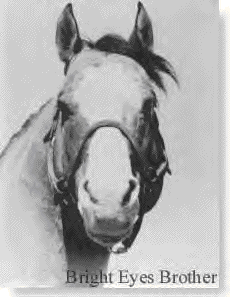 |
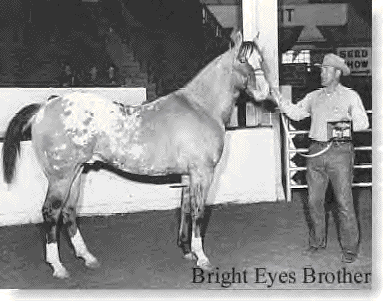 |
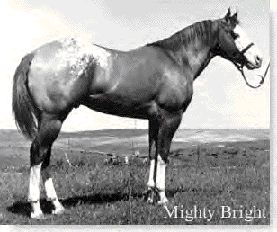 |
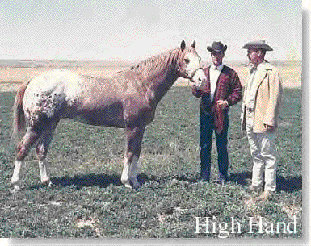 |
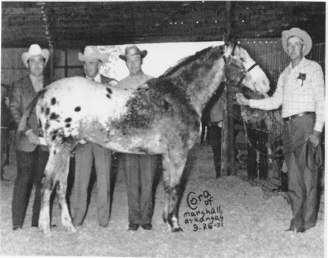 |
Hands Up
World & Nat'l Ch. Sire
Leading App Sire
Sire of Halter & Perf Earners
Advanced from registration ApHC T184 to F2217
Breeder: Mrs. Mae McKinley, Tehona, TX bay, white w/blk spots l/h
|
Foaled May 13, 1952, High Hand was proof that good things can come in small packages. Bred by Buddy Heaton, High Hand’s sire was a stallion Heaton used in his rodeo clown act by the name of Hands Up (who was a descendent of legendary racehorses Man O’ War and Traveler), and out of AQHA mare Deacon Bess. As a foal, the tiny, fox-eared High Hand could be seen being carried around in Heaton's arms. When fully grown, the baldfaced sorrel blanketed stallion was barely 14 hands high, belying his lofty name.
Buddy Heaton trained High Hand in rodeo fare, entering the stallion in rodeo events and match races. Heaton would often challenge riders to races against High Hand, knowing the challenged would think it impossible that the miniscule horse could win a race with the 200 pound Heaton aboard. But High Hand usually prevailed, his racing blood proving useful as he and Heaton dashed across the finish line ahead of their baffled challengers.
But besides his "regular" training, Heaton also trained the clever High Hand for his rodeo clown act. Besides the initial comic appearance of the tall, thin Heaton aboard the diminutive Appaloosa, High Hand was also taught a variety of tricks, which included smiling, pretending to bite Heaton’s rear end, sitting, laying down, counting, and, when Heaton put his hands on the horse’s back, jumping straight into the air, creating the illusion that had lifted him. High Hand was also very adept at walking on his hind legs – something he not only enjoyed doing for a crowd but was quite adept at. High Hand also had a talent for improvisation. At the Denver National Western Stock Show in 1957, the horse Heaton was to ride in the bulldogging class was unable to be ridden. Heaton instead used High Hand – who had never been used in bulldogging before – and rode a clean round in 6.7 seconds, winning the class.
In 1958, two years after being registered with the Appaloosa Horse Club, High Hand was sold to L.G. Blackmer for $10,500, an astounding price for an unknown and unproven stallion. Blackmer’s son-in-law John Albright was put in charge of High Hand’s care. Albright moved High Hand to his LaVeta, Colorado ranch, and showed him to grand champion Appaloosa stallion at the 1960 Colorado State Fair, as well as to reserve grand champion Appaloosa stallion at the Denver National Western Stock show two years running (behind Bright Eyes Brother in 1960 and Quinta Chief in 1961). High Hand also continued to be shown in performance events, including reining and cutting. He was retired from shows, however, when he was continually disqualified from cutting events. The reason? High Hand’s prowess at clowning skills had led him to begin cutting cattle on his hind legs.
In 1962 High Hand was no longer an unproven sire, and the now well-known stallion was sold for $24,500 to breeder Dwight Parks of Waco, Texas, where he continued to produce get that could win in shows or on the racetrack. In 1966, High Hand was sold to a syndicate of Colorado breeders consisting of Dean Davis, David Walker, Harold Calhoun, and Martin Abrahamsen for $60,500. Shortly after their purchase, Davis and Walker were bought out by Calhoun and Abrahamsen. High Hand was moved back to Colorado, where he was the Get of Sire Champion at the Mountain and Plains Appaloosa Horse Club Show for nine consecutive years (1967-1975).
High Hand’s list of accomplished offspring is lengthy, as the stallion was the sire of nearly 400 horses. His racing heritage is evident in several of his offspring; he is the sire of 21 race starters and 9 winners – many of whom are also winners in the show ring as well. His most famous daughter, Ipana Maid, is a member of the Appaloosa Horse Club Racing Hall of Fame; other winning High Hand racing get include World Wide Derby winners Doctor Judge and Patty Hand. High Hand was just as potent as a sire of show horses. High Hand sired Mighty High, the National Grand Champion Mare in 1967 and Reserve Champion Performance Horse in 1969; and American Girl, National Grand Champion Mare in 1970.
In the early 1980’s, High Hand was moved to Dr. Harbord Cox’s DK Ranch in Pampa, Texas for permanent retirement. By now, the elderly stallion – having traveled hundreds upon hundreds of miles in his life – refused be trailered at all, and it was agreed upon by his owners that he should never have to be moved again. While Cox was not one of High Hand's owners, he was no less than honored to let High Hand live out his retirement on Cox's ranch. While High Hand's lived his last year in luxury (he was provided with his own box stall, pasture, and had a Saint Bernard dog for company), High Hand remained the eccentric stallion he had always been, always sleeping with his head facing north, and always facing east when standing under the shade tree in his pasture. In 1983, High Hand was diagnosed with cancer, and at the age of 31, he was euthanized. He was inducted into the Appaloosa Horse Club Hall of Fame in 1988.
|